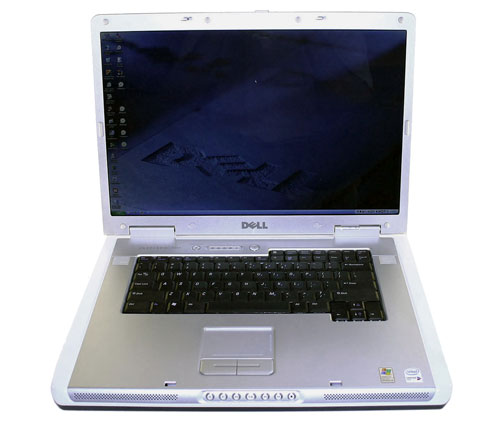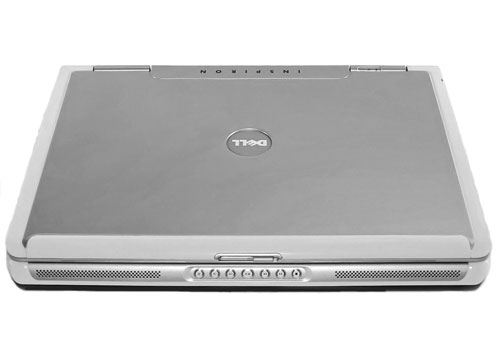Dell DTR Laptop Shootout - M1710 vs. E1705
by Jarred Walton on May 30, 2006 1:30 PM EST- Posted in
- Laptops
Introduction
Several weeks ago, we reviewed the Dell XPS M1710 laptop. The overall performance and features are impressive, but not everyone wants a laptop with a glowing XPS logo. There are also plenty of people out there that would like a large desktop replacement notebook, but they really don't care that much about gaming performance. Even the lowest end XPS laptop still packs quite a bit of gaming power, and while Windows Vista will benefit from having a faster 3D accelerator, it's not due until early 2007, and it still isn't clear which currently available graphics solutions will truly allow you to get the most out of Vista. |
| Click to enlarge |
So what happens if you start with the XPS M1710, drop the fancy paint job, get rid of the glowing lights, downgrade the graphics a bit, but keep everything else the same? The answer is the Dell Inspiron E1705, and quite a few of you have already asked how they compare. The simple answer is that the two are basically identical, other than the bling-bling and graphics card options. The M1710 is essentially the E1705 with most of the high-end component choices. The XPS line also adds the option of choosing a GeForce Go 7900 GTX 512MB graphics card, whereas the Inspiron E1705 tops out with the GeForce Go 7900 GS 256MB.
 |
| Click to enlarge |
While that quick explanation of things does summarize the situation nicely, it glazes over many of the details. For example, how does the faster graphics card affect gaming performance? Which one has better battery life? Does the XPS get noticeably hotter than the E1705? These are all important questions, and we will do our best to provide answers in this follow-up article to the initial M1710 review. We also have two versions of the E1705, one with a GeForce Go 7800 GPU and the other with ATI's Radeon Mobility X1400.
Besides comparing the E1705 and the M1710, we will also take a closer look at the construction of both systems, and we will provide more information on the included components and overall system design. Naturally, both of these laptops are still in the desktop replacement (DTR) category, so if you're looking for a thin and light notebook computer, you will want to look elsewhere. (Dell also has the Inspiron E1505, which reduces the size by going with a 15 inch display.) There are also bigger, faster DTR computers available, so if you want performance and portability above all else, there are perhaps better options. However, the E1705 in particular strikes a good balance between performance, size, and battery life while maintaining a price that, while not cheap, is far more palatable than most of the alternatives.










34 Comments
View All Comments
RedStar - Wednesday, May 31, 2006 - link
"NVIDIA's rating of 400 MHz does not mean manufacturers have to run it that fast"Nvidia's rating very much means the mobile part is capable of 400Mhz --anything less is an underclock.
Why on earth would nvidia publish a spec with the expectation that no one would follow it?
Heck, they could just say we have an 1000Mhz mobile core but too bad everyone will make it go 180Mhz.
Since people are running the go 7800 at 390+MHz without a power upgrade, i would have to say you are very much mistaken about the power draw.
But, i would say the primary issue was two fold.
1)Heat output (thermal profile)
2)To differentiate the product enough from Dell's similiar but ultra expensive XPS line
(of the same february time frame)
I, and others, tend to believe dell was concerned more about #2.
JarredWalton - Thursday, June 1, 2006 - link
NVIDIA wants to put the best face on its product. Just because the chip will run at 400 MHz doesn't mean it can do so within the thermal envelope a manufacturer has for a laptop. I've heard people complain about overheating issues with high-end laptops already, so if Dell plays it a bit safe I won't complain too loudly. I'd really like 1000 MHz RAM with a 333 core say over 400 core and 650-700 RAM.As for protecting the XPS line, the 7900 GS basically fills in the gap. I personally think the GF Go 7800 is going into E1705 because Dell had a bunch of extras from older XPS models. They're downclocking them to reduce power and heat. At 94W measured peak, I would certainly be concerned about long-term usage of a 90W power brick. Unless the 90W rating is conservative, but then why have a 130W for the XPS line?
Anyway, look at the battery life of the 7800 Go compared to the 7900 GTX Go, and then increase the GPU performance by 60%. If you can't have the GPU fall back to the same level (1.1 V and 100 MHz core/658 MHz RAM or something), there are good reasons to not ship a faster GPU. I *still* don't recommend the 7800 Go version, as you would be better with either more battery life (X1400) or better gaming (7900 GS). I just tested what I was sent.
RedStar - Thursday, June 1, 2006 - link
I would agree, the introduction of the 7900GS makes this moot to everyone --except those that bought the i9400 when it first came out and had only the go7800 to choose from (with no reviews yet available --except for the one that said the go 7800 was equal to the ati x1400 [we all then found out why --Dell's 260 core!!]).The limited possibility of a 7900GS upgrade sounds, at least, hopeful.
:)
Andyvan - Wednesday, May 31, 2006 - link
I bought my wife an E1705 a couple of months ago. She doesn't game, so I went with the MX1400. I also went with the slower disk, hoping that would yield lower heat/noise, and longer battery life. I'm curious as to whether I chose well.-- Andyvan
JarredWalton - Wednesday, May 31, 2006 - link
The 7200 RPM HDD kicks power draw up about 2 W when it's active versus sleeping. Really, most laptop parts are already very low power. The X1400 consumes 28W total when idle - most desktops use that much just for the motherboard. The 7200 RPM drives will run slightly warmer than the 5400 RPM models, but they are also about 30% faster in HDD performance. Adding more RAM will often make HDD performance less important, but if you copy files around on the HDD you will definitely notice the difference.Warder45 - Wednesday, May 31, 2006 - link
What about the noise difference in 5400 vs 7200? I've heard that the 7200 HD's can be a lot louder.Yianaki - Wednesday, May 31, 2006 - link
Why can't you have a top of the line 7900 GTX and when watching a DVD or the xp desktop doesn't the graphics card go into basically a sleep mode and turn of almost all the memory. HELL why don't they add a crappy additional teeny transistor space to the gpu chip if it is sooo hard to get the power requirements down on the main GPU. That way they can turn off most of the ram and the gpu and just use this additional teeny transistor space to run simple XP desktop functions or while playing DVD's. I mean a simple xp desktop functions can't take up that much die space. I simply don't get it. I mean this is like the nth graphics card from nvidia and yet it still sucks up the power. I have the horrible intel onboard graphics on my laptop and apart from it eating up some of my precious ram I am EXTREMELY happy with it doing regular desktop XP tasks. Sucks ass for gaming of course. I mean how hard is it for nvidia to totally turn off pretty much all of the GPU when just in desktop mode. Is the huge power difference just because of the high performance memory used? There really shouldn't be a penalty for getting top o' the line graphics I believe.mindless1 - Tuesday, May 30, 2006 - link
From the article,"Why would anyone want to get the X1400 in such a laptop? Obviously, because it uses far less power than even the GeForce Go 7800."
More like, most people are not gamers and of those who are, many will prefer gaming on their desktop. The % of people that will buy a laptop with gaming in mind is miniscule, and that brings up the other puzzling part about so many gaming benchmarks of laptops instead of more useful things like HDD & office productivity. Sure, anything can run office but what about working with giant databases, or wifi range, or most of the parameters that matter to most prospective laptop buyers. Gaming just isn't important at all if it were the same price. Now subtract the price difference and you see why anyone, actually most people do not pay for the gaming GPU inside.
Blahman - Wednesday, May 31, 2006 - link
Hardly... notebook sales have surpassed desktop sales recently.Desktops are on the way out if you ask me. Even if you're a gamer. There are notebooks out there already that have SLI, and the Core Duo architecture is the future of all Intel processors, and it STARTED in notebooks.
Every new notebook generation closes the performance and price gap between desktops and notebooks.
I recently configured and ordered a nice E1705 with the 7900 GS (which I really wish AnandTech had included in the benchmarks, it's more than twice as fast as the 7800 Go) for $1250 (with a $750 coupon code). Skimp on the RAM and go for a $180 aftermarket 2GB PC2-5300 upgrade.
Later on down the road you will be able to upgrade to Merom, and possibly the 7900 GTX or G80M. For now Dell is keeping their spare 7900 GTXs for warranty repairs and aren't currently for sale, but like the last generation with the 7800 GTX, it may be available in the future from Dell Spare Parts.
For tons of more info about these models check out http://www.notebookforums.com/forumdisplay.php?f=1...">the Dell 17" Notebooks section at notebookforums.com.
ElFenix - Tuesday, May 30, 2006 - link
who buys a 9 pound notebook with somewhat horrific battery life regardless unless they're gaming? an external display hooked up to a 15" or 14" 6 pound notebook would be far more useful to the user you're describing.and don't forget that this IS a gaming oriented website.